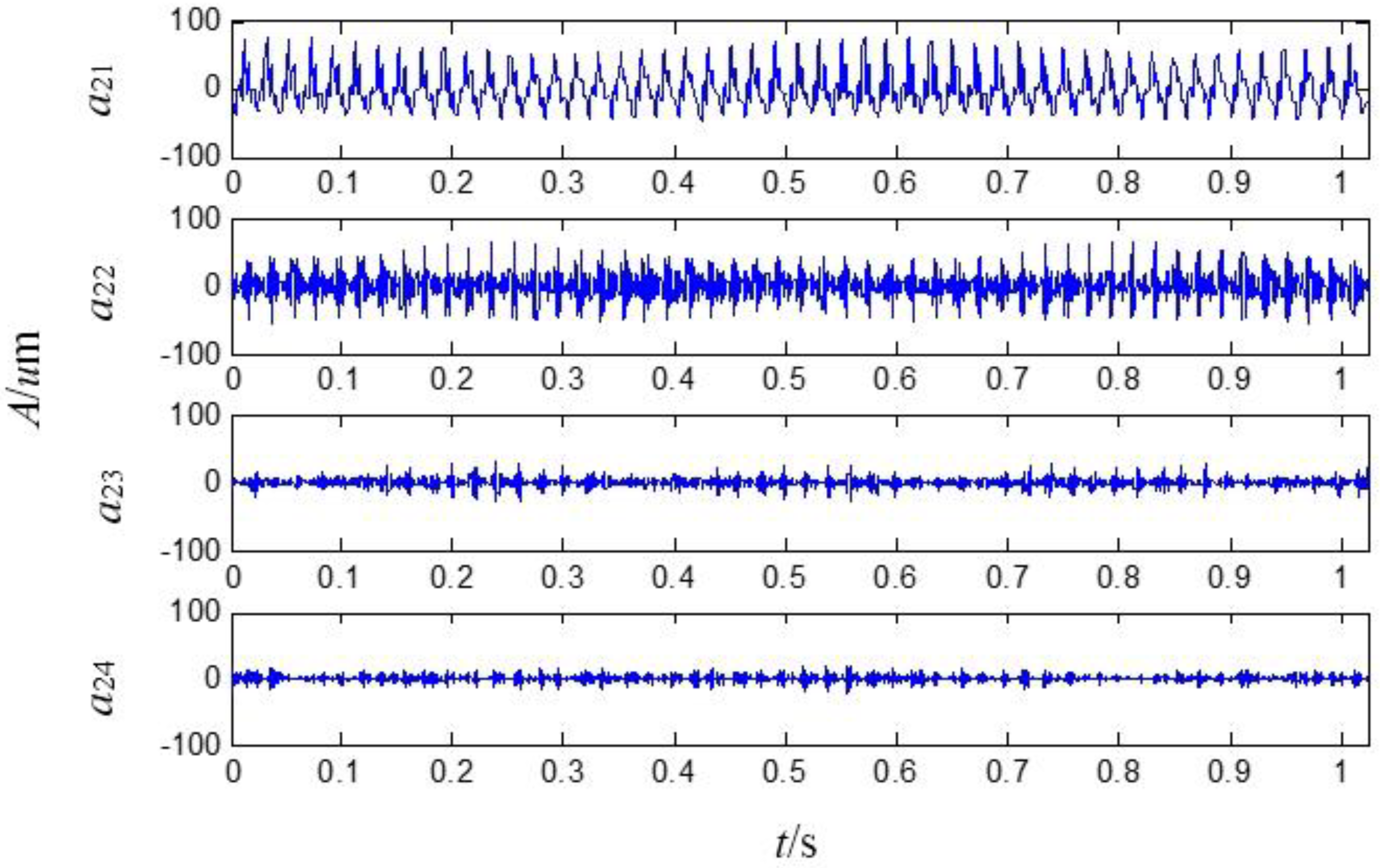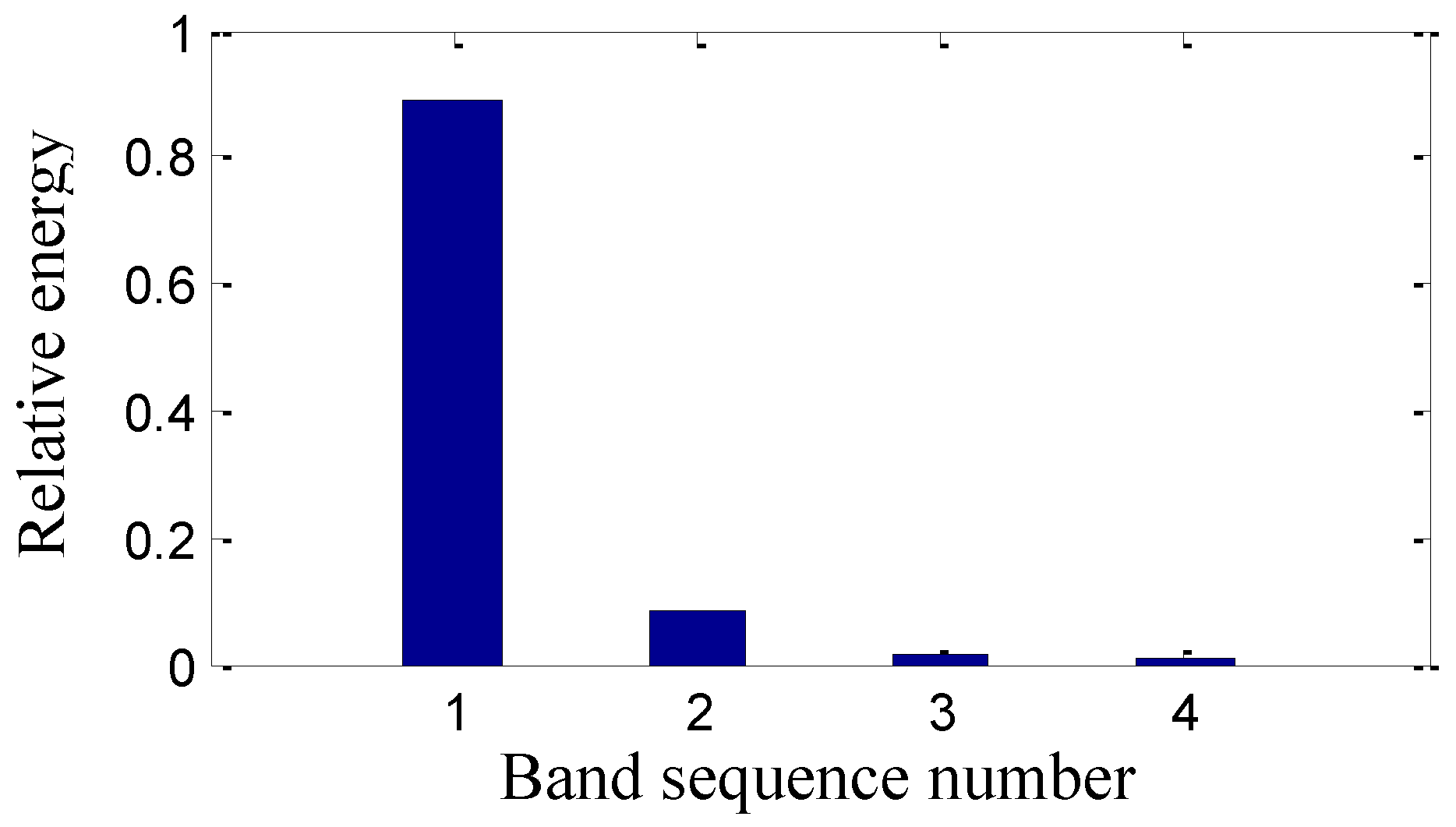Operational Safety Assessment of Turbo Generators with Wavelet Rényi Entropy from Sensor-Dependent Vibration Signals
Abstract
:1. Introduction
2. Theory Background
2.1. Probability Space and Random Variable
2.2. Rényi Entropy
3. Operational Safety Assessment with Wavelet Rényi Entropy from Sensor-Dependent Vibration Signals
3.1. Second Generation Wavelet Package Transform (SGWP)
- Decomposition

- 2.
- Reconstruction
3.2. Energy Distribution of Second Generation Wavelet Package Transform
3.3. Operational Safety Degree with Wavelet Rényi Entropy from Sensor-Dependent Vibration Signals

4. Application in Operational Safety Assessment of a Turbo Generator
4.1. Sensor-Dependent Vibration Signal Monitoring and Acquisition




4.2. Sensor-Dependent Vibration Signal Analysis






4.3. Operational Safety Assessment with Wavelet Rényi Entropy from Sensor-Dependent Vibration Signals
| Decomposition Level | l = 2 | l = 3 | l = 4 |
|---|---|---|---|
| Operational safety degree | 0.3363 | 0.2467 | 0.2812 |
4.4. Fault Diagnosis








4.5. Operational Safety Assessment after Maintenance
| Decomposition Level | l = 2 | l = 3 | l = 4 |
|---|---|---|---|
| Operational safety degree | 0.8627 | 0.8278 | 0.8060 |
4.6. Discussion on the Operational Safety Assessment Influenced by Decomposition Level l of the Second Generation Wavelet Package Transform
4.7. Discussion of the Operational Safety before and after Maintenance

4.8. Operational Safety Assessment with Wavelet Rényi Entropy in Comparison with Wavelet Entropy
| Method | Decomposition Level | l = 2 | l = 3 | l = 4 |
|---|---|---|---|---|
| wavelet entropy | Before maintenance | 0.3564 | 0.2631 | 0.3034 |
| After maintenance | 0.6956 | 0.6663 | 0.6493 | |
| Difference between before and after maintenance | 0.3392 | 0.4032 | 0.3459 | |
| wavelet Rényi entropy | Before maintenance | 0.3363 | 0.2467 | 0.2812 |
| After maintenance | 0.8627 | 0.8278 | 0.8060 | |
| Difference between before and after maintenance | 0.5264 | 0.5811 | 0.5248 |
5. Conclusions
Acknowledgments
Author Contributions
Conflicts of Interest
References
- Boyce, M.P. Gas Turbine Engineering Handbook, 4th ed.; Butterworth-Heinemann: Oxford, UK, 2011; pp. 803–883. [Google Scholar]
- Matteson, S. Methods for multi-criteria sustainability and reliability assessments of power systems. Energy 2014, 71, 130–136. [Google Scholar]
- Lo Prete, C.; Hobbs, B.F.; Norman, C.S.; Cano-Andrade, S.; Fuentes, A.; von Spakovsky, M.R.; Mili, L. Sustainability and reliability assessment of microgrids in a regional electricity market. Energy 2012, 41, 192–202. [Google Scholar]
- Moharil, R.M.; Kulkani, P.S. Generator system reliability analysis including wind generators using hourly mean wind speed. Electr. Power Compon. Syst. 2008, 36, 1–16. [Google Scholar]
- Whyatt, P.; Horrocks, P.; Mills, L. Steam generator reliability—Implications for apwr codes end standards. Nucl. Energy 1995, 34, 217–228. [Google Scholar]
- Tsvetkov, V.A. A mathematical-model for analysis of generator reliability, including development of defects. Electr. Technol. 1992, 107–112. [Google Scholar]
- Sun, Y.; Wang, P.; Cheng, L.; Liu, H. Operational reliability assessment of power systems considering condition-dependent failure rate. IET Gener. Transm. Dis. 2010, 4, 60–72. [Google Scholar]
- Baraldi, P.; Di Maio, F.; Pappaglione, L.; Zio, E.; Seraoui, R. Condition monitoring of electrical power plant components during operational transients. Proc. Inst. Mech. Eng. Part O J. Risk Reliab. 2012, 226, 568–583. [Google Scholar] [Green Version]
- Dumoulin, C.; Karaiskos, G.; Sener, J.Y.; Deraemaeker, A. Online monitoring of cracking in concrete structures using embedded piezoelectric transducers. Smart Mater. Struct. 2014, 23. [Google Scholar] [CrossRef]
- Qiu, L.; Yuan, S.F.; Chang, F.K.; Bao, Q.; Mei, H.F. On-line updating gaussian mixture model for aircraft wing spar damage evaluation under time-varying boundary condition. Smart Mater. Struct. 2014, 23. [Google Scholar] [CrossRef]
- Lu, F.; Huang, J.Q.; Xing, Y.D. Fault diagnostics for turbo-shaft engine sensors based on a simplified on-board model. Sensors 2012, 12, 11061–11076. [Google Scholar]
- Li, Z.J.; Liu, Y.; Liu, F.X.; Yang, X.J. Hybrid reliability model of hydraulic turbine-generator unit based on nonlinear vibration. Proc. Inst. Mech. Eng. Part C J. Mech. Eng. Sci. 2014, 228, 1880–1887. [Google Scholar]
- Hua, C.; Zhang, Q.; Xu, G.H.; Zhang, Y.Z.; Xu, T. Performance reliability estimation method based on adaptive failure threshold. Mech. Syst. Signal Process. 2013, 36, 505–519. [Google Scholar]
- Canovas, J.S.; Kupka, J. On the topological entropy on the space of fuzzy numbers. Fuzzy Set Syst. 2014, 257, 132–145. [Google Scholar]
- Celik, T. Spatial entropy-based global and local image contrast enhancement. IEEE Trans. Image Process. 2014, 23, 5298–5308. [Google Scholar]
- Yin, Y.; Shang, P.J. Weighted multiscale permutation entropy of financial time series. Nonlinear Dyn. 2014, 78, 2921–2939. [Google Scholar]
- Silva, J.F.; Parada, P. On the convergence of shannon differential entropy, and its connections with density and entropy estimation. J. Stat. Plan. Inference 2012, 142, 1716–1732. [Google Scholar]
- Konig, R.; Renner, R.; Schaffner, C. The operational meaning of min- and max-entropy. IEEE Trans. Inf. Theory 2009, 55, 4337–4347. [Google Scholar]
- Beigi, S.; Gohari, A. Quantum achievability proof via collision relative entropy. IEEE Trans. Inf. Theory 2014, 60, 7980–7986. [Google Scholar]
- Qu, J.X.; Zhang, Z.S.; Wen, J.P.; Guo, T.; Luo, X.; Sun, C.; Li, B. State recognition of the viscoelastic sandwich structure based on the adaptive redundant second generation wavelet packet transform, permutation entropy and the wavelet support vector machine. Smart Mater. Struct. 2014, 23. [Google Scholar] [CrossRef]
- Si, Y.; Zhang, Z.S.; Liu, Q.; Cheng, W.; Yuan, F.C. Detecting the bonding state of explosive welding structures based on eemd and sensitive imf time entropy. Smart Mater. Struct. 2014, 23. [Google Scholar] [CrossRef]
- Huang, C.W.; Sue, P.D.; Abbod, M.F.; Jiang, B.C.; Shieh, J.S. Measuring center of pressure signals to quantify human balance using multivariate multiscale entropy by designing a force platform. Sensors 2013, 13, 10151–10166. [Google Scholar]
- Yu, B.; Liu, D.D.; Zhang, T.H. Fault diagnosis for micro-gas turbine engine sensors via wavelet entropy. Sensors 2011, 11, 9928–9941. [Google Scholar]
- Sawalhi, N.; Randall, R.B.; Endo, H. The enhancement of fault detection and diagnosis in rolling element bearings using minimum entropy deconvolution combined with spectral kurtosis. Mech. Syst. Signal Process. 2007, 21, 2616–2633. [Google Scholar]
- Tafreshi, R.; Sassani, F.; Ahmadi, H.; Dumont, G. An approach for the construction of entropy measure and energy map in machine fault diagnosis. J. Vib. Acoust. 2009, 131. [Google Scholar] [CrossRef]
- He, Y.Y.; Huang, J.; Zhang, B. Approximate entropy as a nonlinear feature parameter for fault diagnosis in rotating machinery. Meas. Sci. Technol. 2012, 23. [Google Scholar] [CrossRef]
- Wu, S.D.; Wu, P.H.; Wu, C.W.; Ding, J.J.; Wang, C.C. Bearing fault diagnosis based on multiscale permutation entropy and support vector machine. Entropy 2012, 14, 1343–1356. [Google Scholar]
- Rényi, A. On measures of entropy and information. In Proceedings of the 4th Berkeley Symposium on Mathematics, Statistics and Probability, Berkeley, CA, USA, 20–30 June 1960; pp. 547–561.
- Shannon, C.E. A mathematical theory of communication. Bell Syst. Tech. J. 1948, 27, 623–656. [Google Scholar]
- Shannon, C.E. Communication theory of secrecy systems. Bell Syst. Tech. J. 1949, 28, 656–715. [Google Scholar]
- Fehr, S.; Berens, S. On the conditional Renyi entropy. IEEE Trans. Inf. Theory 2014, 60, 6801–6810. [Google Scholar]
- Nanda, A.K.; Sankaran, P.G.; Sunoj, S.M. Renyi’s residual entropy: A quantile approach. Stat. Probab. Lett. 2014, 85, 114–121. [Google Scholar]
- Endo, T.; Omura, K.; Kudo, M. Analysis of relationship between renyi entropy and marginal bayes error and its application to weighted naive bayes classifiers. Int. J. Pattern Recognit. Artif. Intell. 2014, 28. [Google Scholar] [CrossRef]
- Nagy, A.; Romera, E. Relative renyi entropy for atoms. Int. J. Quantum Chem. 2009, 109, 2490–2494. [Google Scholar]
- Lake, D.E. Renyi entropy measures of heart rate gaussianity. IEEE Trans. Bio-Med. Eng. 2006, 53, 21–27. [Google Scholar]
- Sweldens, W. The lifting scheme: A construction of second generation wavelets. SIAM J. Math. Anal. 1998, 29, 511–546. [Google Scholar]
- Daubechies, I.; Sweldens, W. Factoring wavelet transforms into lifting steps. J. Fourier Anal. Appl. 1998, 4, 247–269. [Google Scholar]
- Sweldens, W. The lifting scheme: A custom-design construction of biorthogonal wavelets. Appl. Comput. Harmonic Anal. 1996, 3, 186–200. [Google Scholar]
© 2015 by the authors; licensee MDPI, Basel, Switzerland. This article is an open access article distributed under the terms and conditions of the Creative Commons Attribution license (http://creativecommons.org/licenses/by/4.0/).
Share and Cite
Zhang, X.; Wang, B.; Chen, X. Operational Safety Assessment of Turbo Generators with Wavelet Rényi Entropy from Sensor-Dependent Vibration Signals. Sensors 2015, 15, 8898-8918. https://doi.org/10.3390/s150408898
Zhang X, Wang B, Chen X. Operational Safety Assessment of Turbo Generators with Wavelet Rényi Entropy from Sensor-Dependent Vibration Signals. Sensors. 2015; 15(4):8898-8918. https://doi.org/10.3390/s150408898
Chicago/Turabian StyleZhang, Xiaoli, Baojian Wang, and Xuefeng Chen. 2015. "Operational Safety Assessment of Turbo Generators with Wavelet Rényi Entropy from Sensor-Dependent Vibration Signals" Sensors 15, no. 4: 8898-8918. https://doi.org/10.3390/s150408898






